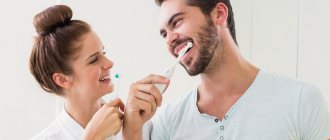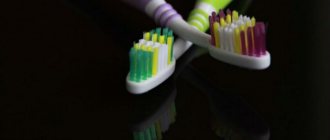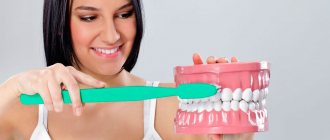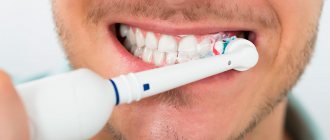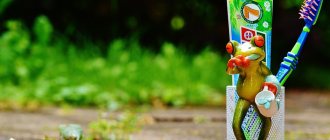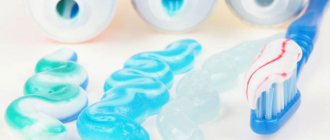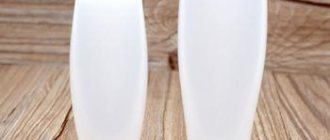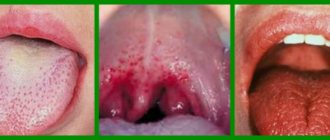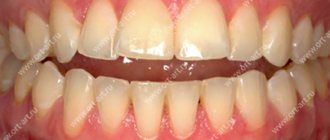Many well-known companies produce toothbrushes in parallel with their main production. Such related production contributes to the effective promotion of pastes, since the auxiliary product is an additional advertising medium and an integral element of the morning routine.
A thousand years ago, people brushed their teeth with twigs, and in the 19th century, with the scruff of pigs. Therefore, a modern device made of synthetic material and plastic deserves all praise.
At the very beginning of production, toothbrushes are small plastic balls that are sucked into a mold by a vacuum.
There, the raw materials are melted under the influence of temperature conditions into a thick mass, which is then poured into a large metal mold.
It is this device that simultaneously produces 10 bases for the future brush.
There are 56 holes on each brush head.
The machine produces 10 bases every 35 seconds (27,000 pieces per day).
Then the colored rubber balls are melted. Liquid rubber flows through the pipes, and with the help of a press they begin to attach it to the bases. Bristles are made from nylon fibers.
First, the raw material is leveled by the “mechanical arm” of the unit, and then, at instant speed, the machine inserts the bristles into the holes of the base head. For each hole, 22-24 bristles are automatically selected.
An automated system functions faster than any human, so manual labor in this production process is categorically unacceptable. From the point of view of the hygienic aspect, everything here is also done at a safe level, since specialists do not touch the bristles.
Next, the machine bends the fibers in half and hooks them onto the wire, which is stretched in the middle of the brush.
After the stubble has been reliably strengthened, it’s time for a short haircut. The blades cut all the bristles to the same length. Their edges are given different shapes, which directly depend on the model of the batch being produced.
Next, the bristles are lightly polished using rotating discs coated with diamond.
This stage ends after giving it the required shape (smooth, zigzag, wavy, etc.). The bristles come in different colors; this decision is a purely aesthetic issue. Particularly fashionable combinations of shades lead to high sales volumes. The automatic machine is also responsible for the coloring process.
Spot checks of the finished product are carried out periodically. When the nylon coil is removed from the brush, the reliability of the bristles is examined. If the test is successfully passed, the entire batch is sent for sale. Then the automatic system starts packing the brushes, they come off the conveyor and are transported into boxes.
Nutrition
Power supply for electric toothbrushes
According to the method of power supply, electric toothbrushes are divided into three categories:
- Works from a socket . By choosing such an electric toothbrush, you can brush your teeth as much as you like, it will not turn off, and it will be powerful enough. But you can’t take it on a trip; there’s not always an outlet nearby.
- Battery powered . Not dependent on the network, you can brush your teeth anytime, anywhere. But it is not always convenient to change the battery; manufacturers often equip models with non-removable batteries. And the brush can take a long time to charge, sometimes up to 10 hours.
- Battery operated . Such models also allow you to brush your teeth where there is no outlet. Usually they are bought for business trips or travel. Batteries have an advantage over a battery - they are easier to change.
The more toothpaste, the better the effect.
Not certainly in that way. The quality of cleaning primarily depends on the technique and choice of brush. Even a small amount of toothpaste, about the size of a pea, will help to effectively perform oral hygiene. By the way, electric brushes are very convenient in this regard - you can set the desired mode and enjoy the process.
How to choose heads for electric toothbrushes?
Types of toothbrush heads
When thinking about which electric toothbrush to choose, you should pay close attention to the heads. The brush can come with a different set, based on family members or functions.
A standard set of nozzles looks like this:
- A nozzle for every day.
- For a child.
- For sensitive teeth.
- For whitening.
Some manufacturers have attachments for cleaning the space between teeth and for braces.
If you choose a budget brush, then the kit may only come with one attachment. And then the rest are bought separately. To choose the right attachments for an electric toothbrush, consult your doctor. Based on your medical history, he will tell you which ones are right for you.
Bristle hardness level
The main cleaning element of any toothbrush is the bristles, the action of which allows you to remove food debris, plaque and harmful bacteria from the surface of the teeth, tongue and gums. Taking this factor into account, there are the following groups of toothbrushes:
- Brushes with soft bristles are most often intended for use by young children, patients after surgery, for teeth with damaged enamel, a tendency to wear off the enamel, and wedge-shaped pathologies.
- Hygiene items with medium-hard bristles are standard toothbrushes that provide optimal cleaning and are suitable for regular use for people with healthy teeth.
- Stiff toothbrushes are useful when cleaning dentures or orthodontic appliances.
Additional features of electric toothbrushes
Additional functions of toothbrushes
Among the additional functions of electric toothbrushes, the following should be noted:
- Timer . An option that limits the time spent brushing your teeth. Sometimes we get carried away, brushing our teeth longer than necessary, thereby damaging the enamel. The timer should be set for a couple of minutes.
- Pressure control . This feature will be useful for you if you lean heavily on the device. As soon as the pressure on the enamel exceeds the norm, you will hear a sound or the brush will turn off.
- “Time to change the nozzle” indicator . Typically, manufacturers dye the bristles, and when the color is already pale, it means it's time to buy a new head.
- Charger . When choosing an electric toothbrush, buy one with a charger if it is important that the device does not run out of charge at the wrong time. It’s also convenient to use the station as a stand.
- Disinfector . You can usually buy it separately from the brush. Needed to disinfect attachments using UV rays.
How electric brushes work
If you compare the efforts made to brush your teeth with a regular brush, which everyone is accustomed to since childhood, and an electric one, then the advantages will undoubtedly be with the latter. After all, the 2-3-5 minutes that you need to spend carefully cleaning all surfaces, corners, spaces and grooves in your teeth, while straining your fingers, sometimes turning your hand in the right direction, can be successfully replaced with a simplified process, spending much more on it less time and effort. And an electric toothbrush will save this time.
The secret is simple: a special motor is built into the body of such a brush, and with its help the bristles are set to a certain speed. In addition, the bristles have the ability to change the direction of their rotation: from circular rotation to up and down movement. It is this ability of the bristles that allows you to more thoroughly clean accumulated dirt, and simply complete cleaning several times faster.
Useful tips
What else should you pay attention to when choosing an electric toothbrush?
Let's summarize, or tips on how to choose an electric toothbrush for an adult:
- Please consult your dentist before purchasing. Your doctor will give you the most important advice based on your oral health.
- Don't waste money on a good toothbrush. It will cost less than treatment in a clinic.
- It is better to choose a device that comes with a small nozzle. It will help take care of hard-to-reach places.
- Please note that an electric brush requires a softer paste (look at the RDA tube, no higher than 50).
What and how to brush your teeth if you don’t have toothpaste?
There are situations when a tube of paste is completely empty, and there is no time or desire to run to the store for a new one.
What to do? Do you really have to go to work or school with unbrushed teeth and cover your mouth every time you have contact with other people? No, you can find toothpaste substitutes at home, which will be no worse in effect, maybe even better .
Tea tree oil
In addition to the usual remedy, you can brush your teeth with tea tree oil, rubbing it into the tooth enamel . It has an amazing whitening effect that occurs naturally, without any harmful effects or destruction.
Tea tree oil will not only help clean teeth from plaque, but also strengthen enamel, prevent inflammation and disinfect the oral cavity .
By the way! It is worth paying attention to a significant disadvantage of the product - a sharp, specific smell and bitter taste.
Salt
Table salt is extremely effective for cleaning teeth, as it has antiseptic, anti-inflammatory and regenerating effects . Salt can eliminate bad breath.
It's extremely easy to use:
- dip the brush in water;
- apply salt to it;
- clean without sudden movements or strong pressure.
Baking soda
Baking soda can clean enamel well, but you should only use it in extreme cases. With frequent use, it can damage the enamel, depleting it .
Experts recommend brushing your teeth with baking soda no more than once a week .
Cleaning with baking soda is equivalent to professional cleaning (in terms of impact).
Powdered milk
Powdered milk is ideal for those who suffer from bleeding gums or who have tartar . It eliminates unpleasant odors well, however, the effect is short-lived.
Powdered milk must be used as a dry powder.
Clay powder
Clay powder requires extra effort to create, but the effect is worth it. Your teeth will be noticeably whiter after the first use.
For cooking you need:
- Dry the white clay.
- Grind it into powder.
- Add a couple of drops of your favorite essential oil to eliminate unpleasant odor and taste (fir or mint is recommended).
For your information! You can buy ready-made white clay powder in stores, however, it will cost much more.
Activated carbon
Activated carbon not only makes teeth whiter, but also removes age spots, normalizes oral microflora, and fights toxins .
Like others, good ones eliminate bad breath. It is not recommended to use activated carbon as a paste on an ongoing basis, as it can damage the enamel .
Hydrogen peroxide
Hydrogen peroxide can be considered as a toothpaste substitute. Like baking soda, the solution is analogous to professional teeth cleaning, however, it is more gentle .
Important! It is not recommended to use more than once a week.
Hydrogen peroxide will eliminate yellowness, remove unpleasant odor, and also have an antiseptic effect.
How to choose the right brush for a child?
How to choose an electric toothbrush for a child?
A children's toothbrush can be distinguished from an adult toothbrush by the following points:
- It has a shorter handle, there is an elastic band on the body, and the design itself is designed so that the brush fits comfortably in the baby’s hand.
- Runs at a lower speed.
- The nozzle size is smaller.
- The bristles are the softest.
- Bright design to make brushing your child's teeth interesting.
Age characteristics of buyers
The range of modern manufacturers includes models for people of different ages: small children from 6 months and older age groups. Taking this factor into account, hygiene items can be presented in the following variations:
- Toothbrushes for small children of preschool age. For users aged 6 months and older, silicone caps with soft bristles are designed to clean the surface of baby teeth from food debris.
- Children from 2 to 7 years old can use toothbrushes with a standard design, a small number of rows and low bristles. The main objective of such a procedure is to teach oral hygiene standards, which is why toothbrushes have a colorful design and are equipped with light and sound indicators for the end of cleaning.
- For school-age children and teenagers who have baby and permanent teeth, the brush has long bristles of varying lengths and a wide handle in bright colors.
- Toothbrushes for adults have a standard design and may differ in the degree of stiffness of the bristles.
Rules for cleaning the tooth surface
When using electric models, you can start brushing your teeth from both the lower and upper jaws. It is better if the cleansing process takes you at least 2-3 minutes. In this case, you need to linger on one tooth for 2-3 seconds. During the procedure, do not make any additional movements with your hand, just smoothly move the brush from one tooth to another. The device is already programmed to perform certain rotational and translational movements.
When cleaning the outer surface of the teeth , the bristles should adhere to the enamel at right angles. Movements and pulsations should be as smooth as possible. The external cleaning procedure covers the entire surface of the tooth, right down to the gums.
Caring for the back surface of teeth - just as in the previous case, the brush should move smoothly from one tooth to another. For greater convenience, the device is rotated vertically. It is important that the bristles reach the gums without damaging them. The inside of the teeth is hidden from view, so maximum attention must be paid to it.
Cleaning the chewing surface - Chewing teeth require careful attention, so when brushing, you can use light pressure on the brush. The procedure time for this part also increases to 3-4 seconds. Gradually you will learn to control the pressure.
Cleaning gums - When it comes to cleaning gums, some models have a special attachment designed for this purpose. If there is no attachment, then you can massage soft tissues by turning off the device.
The advantages of using the model are the high quality of enamel cleaning, as well as ease of operation. In the absence of contraindications, such devices are recommended even for children. Correct use of the device facilitates the treatment of certain oral diseases.
What to do if you don't have a brush at hand
The best tools for brushing your teeth are, of course, a toothbrush and floss, but what if you don’t have either of those on hand to clean your teeth in this case? It would be good if you have:
- Towel, cloth, bandage or cotton wool . To use, wrap the material around your finger, wet it, and then dip it in toothpaste or an alternative mixture. Next, you should brush your teeth as you would with a brush: in a circle from top to bottom, trying to clean each tooth. After this, it’s good not to forget about the language. After completing the procedure, rinse your mouth.
- Twig . This device was used long before the invention of our usual means. You will need a twig about 15-25 cm long, cleared of bark and peel. The core of the twig needs to be chewed until the fibers separate and turn into something like a toothbrush.
- Specialized mouth rinse.
- Dental floss.
- Just a finger . You can use it, but be sure to follow the rules of hygiene (clean your hands well before and after the procedure).
As you can see, brushing your teeth without toothpaste and/or a brush is not difficult - if only you have the desire, imagination and knowledge.
